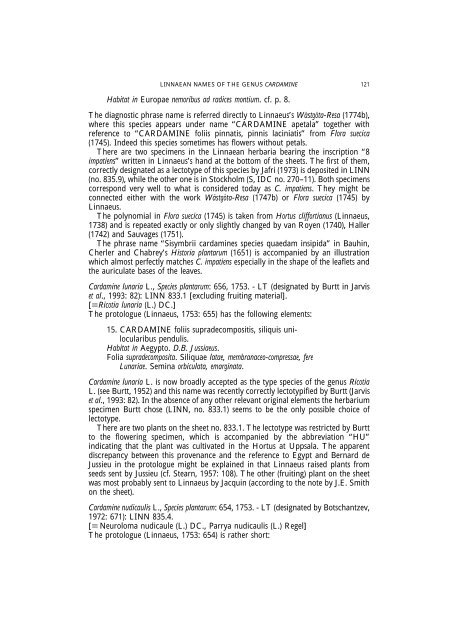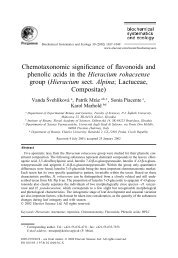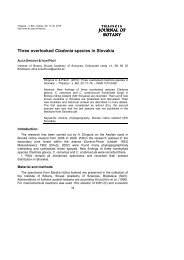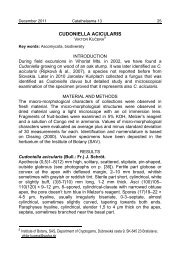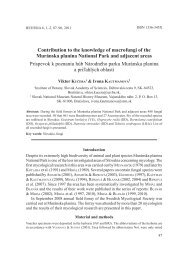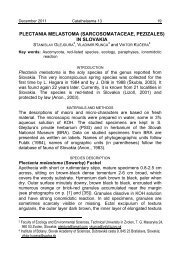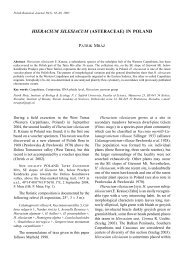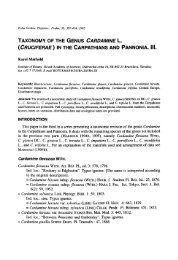Typification of the Linnaean names of the genus - institute of botany ...
Typification of the Linnaean names of the genus - institute of botany ...
Typification of the Linnaean names of the genus - institute of botany ...
You also want an ePaper? Increase the reach of your titles
YUMPU automatically turns print PDFs into web optimized ePapers that Google loves.
LINNAEAN NAMES OF THE GENUS CARDAMINE<br />
Habitat in Europae nemoribus ad radices montium. cf. p. 8.<br />
The diagnostic phrase name is referred directly to Linnaeus’s Wästgöta-Resa (1774b),<br />
where this species appears under name “CARDAMINE apetala” toge<strong>the</strong>r with<br />
reference to “CARDAMINE foliis pinnatis, pinnis laciniatis” from Flora suecica<br />
(1745). Indeed this species sometimes has flowers without petals.<br />
There are two specimens in <strong>the</strong> <strong>Linnaean</strong> herbaria bearing <strong>the</strong> inscription “8<br />
impatiens” written in Linnaeus’s hand at <strong>the</strong> bottom <strong>of</strong> <strong>the</strong> sheets. The first <strong>of</strong> <strong>the</strong>m,<br />
correctly designated as a lectotype <strong>of</strong> this species by Jafri (1973) is deposited in LINN<br />
(no. 835.9), while <strong>the</strong> o<strong>the</strong>r one is in Stockholm (S, IDC no. 270–11). Both specimens<br />
correspond very well to what is considered today as C. impatiens. They might be<br />
connected ei<strong>the</strong>r with <strong>the</strong> work Wästgöta-Resa (1747b) or Flora suecica (1745) by<br />
Linnaeus.<br />
The polynomial in Flora suecica (1745) is taken from Hortus cliffortianus (Linnaeus,<br />
1738) and is repeated exactly or only slightly changed by van Royen (1740), Haller<br />
(1742) and Sauvages (1751).<br />
The phrase name “Sisymbrii cardamines species quaedam insipida” in Bauhin,<br />
Cherler and Chabrey’s Historia plantarum (1651) is accompanied by an illustration<br />
which almost perfectly matches C. impatiens especially in <strong>the</strong> shape <strong>of</strong> <strong>the</strong> leaflets and<br />
<strong>the</strong> auriculate bases <strong>of</strong> <strong>the</strong> leaves.<br />
Cardamine lunaria L., Species plantarum: 656, 1753. - LT (designated by Burtt in Jarvis<br />
et al., 1993: 82): LINN 833.1 [excluding fruiting material].<br />
[�Ricotia lunaria (L.) DC.]<br />
The protologue (Linnaeus, 1753: 655) has <strong>the</strong> following elements:<br />
15. CARDAMINE foliis supradecompositis, siliquis unilocularibus<br />
pendulis.<br />
Habitat in Aegypto. D.B. Jussiaeus.<br />
Folia supradecomposita. Siliquae latae, membranaceo-compressae, fere<br />
Lunariae. Semina orbiculata, emarginata.<br />
Cardamine lunaria L. is now broadly accepted as <strong>the</strong> type species <strong>of</strong> <strong>the</strong> <strong>genus</strong> Ricotia<br />
L. (see Burtt, 1952) and this name was recently correctly lectotypified by Burtt (Jarvis<br />
et al., 1993: 82). In <strong>the</strong> absence <strong>of</strong> any o<strong>the</strong>r relevant original elements <strong>the</strong> herbarium<br />
specimen Burtt chose (LINN, no. 833.1) seems to be <strong>the</strong> only possible choice <strong>of</strong><br />
lectotype.<br />
There are two plants on <strong>the</strong> sheet no. 833.1. The lectotype was restricted by Burtt<br />
to <strong>the</strong> flowering specimen, which is accompanied by <strong>the</strong> abbreviation “HU”<br />
indicating that <strong>the</strong> plant was cultivated in <strong>the</strong> Hortus at Uppsala. The apparent<br />
discrepancy between this provenance and <strong>the</strong> reference to Egypt and Bernard de<br />
Jussieu in <strong>the</strong> protologue might be explained in that Linnaeus raised plants from<br />
seeds sent by Jussieu (cf. Stearn, 1957: 108). The o<strong>the</strong>r (fruiting) plant on <strong>the</strong> sheet<br />
was most probably sent to Linnaeus by Jacquin (according to <strong>the</strong> note by J.E. Smith<br />
on <strong>the</strong> sheet).<br />
Cardamine nudicaulis L., Species plantarum: 654, 1753. - LT (designated by Botschantzev,<br />
1972: 671): LINN 835.4.<br />
[� Neuroloma nudicaule (L.) DC., Parrya nudicaulis (L.) Regel]<br />
The protologue (Linnaeus, 1753: 654) is ra<strong>the</strong>r short:<br />
121


